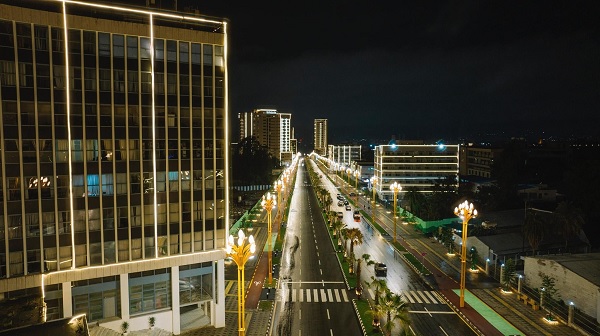
The Ethiopian capital Addis Ababa is being “deconstructed and reconstructed,” to use a terminology from philosophy or literary criticism. Yes, a city, like a narrative in literature, can be deconstructed and reconstructed. In the case of philosophy or literary criticism, deconstruction refers to the process by which something is broken down into its separate parts in order to understand its meaning, especially when this is different from how it was previously understood. Reconstruction, on the other hand, refers to the act of reassembling or the state of being reconstructed.
Yes, Addis Ababa is being deconstructed and reconstructed. It is being broken down into its essential parts in order not to understand its nature or meaning but to see what can be removed and what can be preserved from its old structures, neighborhoods, streets and settlements. The reconstruction phase might be conceived as a process through which the city is assuming new features by discarding old remnants from its past that do not serve its ambition for renewal or modernization.
The deconstruction and reconstruction processes may not be implemented in a way that satisfies all interests, basically the interests of all parties in a fair and balanced way. The interests of the residents are basically to preserve their homes and sanctuaries from demolishing, particularly if they have not a replacement or an alternative to the demolished places of residence. That was also the uproar that followed the demolishing process particularly in the Piazza Arada areas down to Arat Kilo neighborhoods.
The demolishing process was not only implemented hastily but also without the necessary preparations for compensation payments. The city administration and the government in general were eager to modernize the capital but it did not have the funds or compensation payments for compensation to the people who have lost their homes to the demolishing process. The city administration may face a dilemma. It has the ambition and the readiness to redevelop some parts of the capital but it has not the necessary funds at its disposal to pay compensation for the demolished houses.
Moreover, the law on the administration of rural or urban land says that all land belongs to the state without mentioning anything about compensation for losing the houses. The administration is therefore free to claim any land in the city over which it has juridical rights to be reclaimed for any purpose while the residents have no legal right to claim compensations. The redevelopment of Addis Ababa has always been conducted by auctioning the evacuated plots of land and reinvesting the money therefore for redevelopment through joint ventures or by private developers.
The demolishing and occupation of the evacuated plots of land have been conducted relatively peacefully. It seemed that there was some kind of silent consensus between evacuated residents and the city administration, as both parties apparently welcomed the development of the capital as a common ideal. It may be necessary at this point to set aside these issues and focus on the new face of a portion of the neighborhoods that stretch from Piazza or Arada to Arat Kilo along the main street that joins one section to the other.
It was a Saturday afternoon and I was travelling from Bishoftu to Addis Ababa and the transportation problem in the southern part of the capital from Kaliti sub-city to Piazza was simply nerve racking to say the least. If the streets are so clogged on a Saturday, one can easily imagine that it must be crazy to travel along the same road junction on working days.
The first impression this columnist had on arrival at Piazza was a kind of eerie silence with few pedestrians walking along the streets, most of them silent and squinting the area with their eyes as if they were first time visitors. The silence or the feeling of peacefulness was enveloped some parts of the old Piazza was intimidating; except for the Adwa building that was relatively more crowded wits with mostly youngsters, as well as singles and couples, who were there for a photo opportunity.
This writer felt he was a stranger in a city where he grew up going to the movie houses, legendary pastries and cafes, traditional and modern hotels and recreational facilities that are now become history. The old quarters around Doro Manekia with their dilapidated meat shops, drink and kaht joints, with narrow alleys filled with sewerage and garbage and emitting bad smells of discarded and decomposing rubbish and open-air toilets…have all disappeared leaving behind mounds of freshly excavated red soil…well that was but a welcome development and one of the positive aspects of taking place in Piazza.
All the shops, businesses and residential buildings on both sides of the main street that is dissecting Piazza into two and leading to Art Kilo, are now gone. Their place is taken over by vacant plots that are awaiting reconstruction by developers. One of the striking features of that area is its newly acquired sense of cleanness. Cleanness and quietness. The traffic jams are gone together with the overcrowding, the pushing and shoving of pedestrians that were moving in all direction with frenzy.
The “deconstruction” of Piazza has also exposed its soft belly. The narrow and dirty alleys, drinks joints and brothels that were hidden behind tall buildings that were giving the area the semblance of elegance, are now gone. This may not be something to celebrate, given the high costs in terms of human livelihood but it has certainly given way for a reconstruction process that would take both the interests of the developers and the future residents into consideration.
There are also a few structures that have survived the juggernaut of the demolishing process. One of them is the building nearby Ras Mekonen Bridge. The building used to serve, among other things, as the office of the Ethiopian Journalists Association that has long ceased to operate. The narrow alleys and streets leading to Saint George church are now clean, although uninhabited and awaiting potential developers.
As you pass over the bridge, your attention is bound to turn to the river below and the dense and dilapidated residential houses that populated its banks. From the distance, that place now looks like a farming area and not as a once populated river bank. All the houses are gone and the river can be seen flowing silently to the southern quarters of the city. Where have all those old houses and their residents gone now? No one knows but they are not there for the moment.
When you look down at the river, and at the escarpments on both banks, the impression you get is that the area has now become open to curious eyes. In the old days, the old structures above the river used to hide the vision beyond them. Now you have a clear view of Piazza from the distance. you also realize that the river banks are now ready for development the way many river banks in Addis have already been developed. This part of the city will soon be covered with greenery and may be turned into a big park with roads and other facilities, a place bustling with people particularly on weekends and holidays.
The Armenian Orthodox Church along the main street leading to Arat Kilo is an old and medieval looking grey building built almost a century ago on a small plot of land. It has witnessed the passage of time, many historical events and is one of the landmarks in the area. It was a wise decision to preserve it. One day, it may become a tourist attraction for visitors who will come from faraway places and would like to see the inside of that church that may be containing some old religious relics from Eastern orthodoxy.
By the way, it is commendable that the bars and restaurant in front of the church right across the main street are now gone and left their place for new construction to take place. Fortunately, the few buildings around that area have escaped the demolishing work and the bulldozers that do the job.
One of the more remarkable aspects of the renewal process that is taking place on both sides of the street leading from Piazza to Arat Kilo, is that there is enough space available for pedestrians to rest and take a breath, particularly on hot days. There are many seats built along the way where people are sitting alone, or with their friends simply to catch a breath or enjoy conversations. This is a of course a sign that the planners have taken into consideration the needs or comforts of pedestrians. The wooden seats are similar in size and color to those built on both sides of Churchill Road and contribute to the harmony of a city where chaos and contrast was the rule rather than the exception until recently.
It may be time to reach Arat Kilo proper. Almost all the old buildings are now renovated and give you the impression that they are newly built structures. There are also new ones that give the entire area an air of freshness and add sparkle. The main street rather looks broader and pedestrians are given ample space for walking freely. Upon reaching that particular spot, you may miss the hassle and bustle around Jolly bar that is now gone or continues to survive in your memories. You may also imagine the newspaper vendors and readers who shared the space right below Jolly Bar and the pedestrian alleys above it. The buildings around that place are renovated while new structures are added in order to give the area the order and serenity it badly needed.
The impressions you may gather from your short trip may include amazement, surprise, strangeness or shock depending on your moods. However, the undeniable fact is that Addis Ababa in general and that part of the city stretching from Piazza to Arat Kilo is changing in a unique and amazing way as the deconstruction and reconstruction of the capital is continuing with unprecedented zeal.
BY MULUGETA GUDETA
THE ETHIOPIAN HERALD WEDNESDAY 30 OCTOBER 2024


